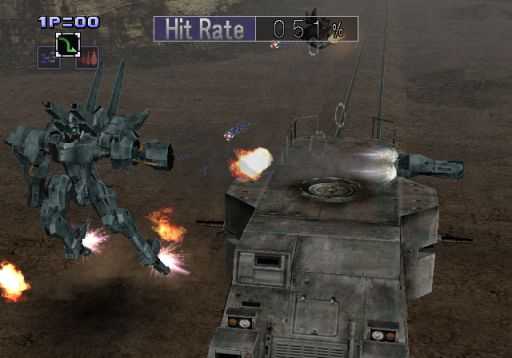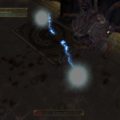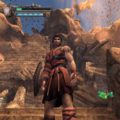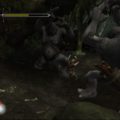I think it’s safe to say that Devil May Cry lit a fire under the 3d action game genre like never before. And honestly, thank god. The transition from 2d to 3d during the PS One era was not pretty. For every Silent Bomber and One there were countless Contra: Legacy of Wars that I shudder thinking about. But DMC changed that by laying down a foundation that even subpar games could follow to remain somewhat enjoyable. Games quickly followed in its wake and one of the most interesting is Gungrave. A number of creative minds teamed up to create this incredibly stylish action extravaganza and it largely succeeds at what it attempts. That is, being one of the tightest action games of that era.
Gungrave is set during the second half of the anime, after the extended flashback is over. Brandon Heat, now known as Beyond the Grave, has returned from the dead to destroy Millenion, the syndicate he was once part of and ultimately betrayed him. In the years since his death Millenion has brought the world to its knees with its new drug that transforms ordinary people into superhuman deadmen. Dismantling the syndicate is doubly personal as its leader, Harry McDowell, is the one who personally killed Brandon.
It’s the classic one man against the world story. But in this case Beyond the Grave came prepared. His twin pistols (Cerberus) pump out infinite ammo at a blistering clip. The lock-on targeting is snappy, prioritizing the biggest threat in the room. If the button is held it will automatically move on to the next targets. The coffin strapped to his back can be used as a AOE bludgeon but more specifically it unleashes your Demolition shots. At first it is a one shot bazooka but as you progress you’ll earn different shots. Demolition shots are also the only way to regain lost health but it comes with a price.
Gungrave is designed around nonstop action. Each level is a series of interconnect rooms and smaller arenas that are highly destructible. New enemies filter in constantly from all sides and there is rarely a quiet moment. For every enemy shot or object broken you build up beats. For every 25 beats you string together you earn a demolition shot. Randomly button mashing can earn high beat counts early on but as the game delays waves or transitions to new areas it gets harder. Truly skilled players will learn how to stagger out kills and constantly stay on the move to keep the counter going. It is possible to get as high as 300-400 combo strings going. Now of course the game doesn’t require it but it does play a factor in your end level grade.
At the end of each level your performance is graded in five categories. Beat count, time taken, enemies killed, artistic score and remaining life. Some of these are self-explanatory and present interesting challenges while trying to get the best score in other categories. Every level has a minimum to beat in order to earn a five skull rank. They also have a beat count, which is usually in the hundreds. Most enemies actively seek you out so you don’t have to chase them. It’s still not easy; Grave doesn’t so much walk but lumbers forward. And his run isn’t anything to speak of. Those are deliberate choices to make you work to earn those ridiculous beat combos. The other two are the most interesting.
I called Gungrave stylish and that plays into the artistic score. There are numerous flourishes you can do that look cool and add to your artistic score. Rapidly pressing the attack button will cause Grave to spin and shoot everything in sight randomly. Performing a dive, either to dodge bullets or just to look cool is another. Remaining life is the kicker. There are no power-ups in the game. Grave has regenerating shield like Halo but that is it. Initially it feels indestructible but by stage 3 it routinely gets shredded. You get so many demolition shots that using one to restore life seems trivial. But it heavily impacts your score, which is used to unlock new demolition shots and extras. Whether it is worth it is up to you.
The extras earned at the end include lots of neat options that affect gameplay. One lets you control the camera. The most prominent is slow motion mode. If you’re thinking of Max Payne forget it. Instead it drops the game’s framerate to simulate slow mo. It’s….interesting and I’ll leave it at that. There is a movie viewer to watch all of the game’s cutscenes and a model viewer to appreciate the game’s gorgeous art direction. There’s even a stage select. All of these bonuses make replaying Gungrave fun but still can’t hide the fact that the game is short. At most on the default setting this is a two hour game. If you don’t care about the bonuses than it becomes a matter of how much you enjoy the base game. I like Gungrave but I can see how many will not feel as though they got their money’s worth.
In Closing
But that was then and this is now. At fifty dollars Gungrave was a hard sell. But now it can be had for a few bucks. At that price it is more than worth diving in. Length aside this is one of the most solid PS2 action games.





